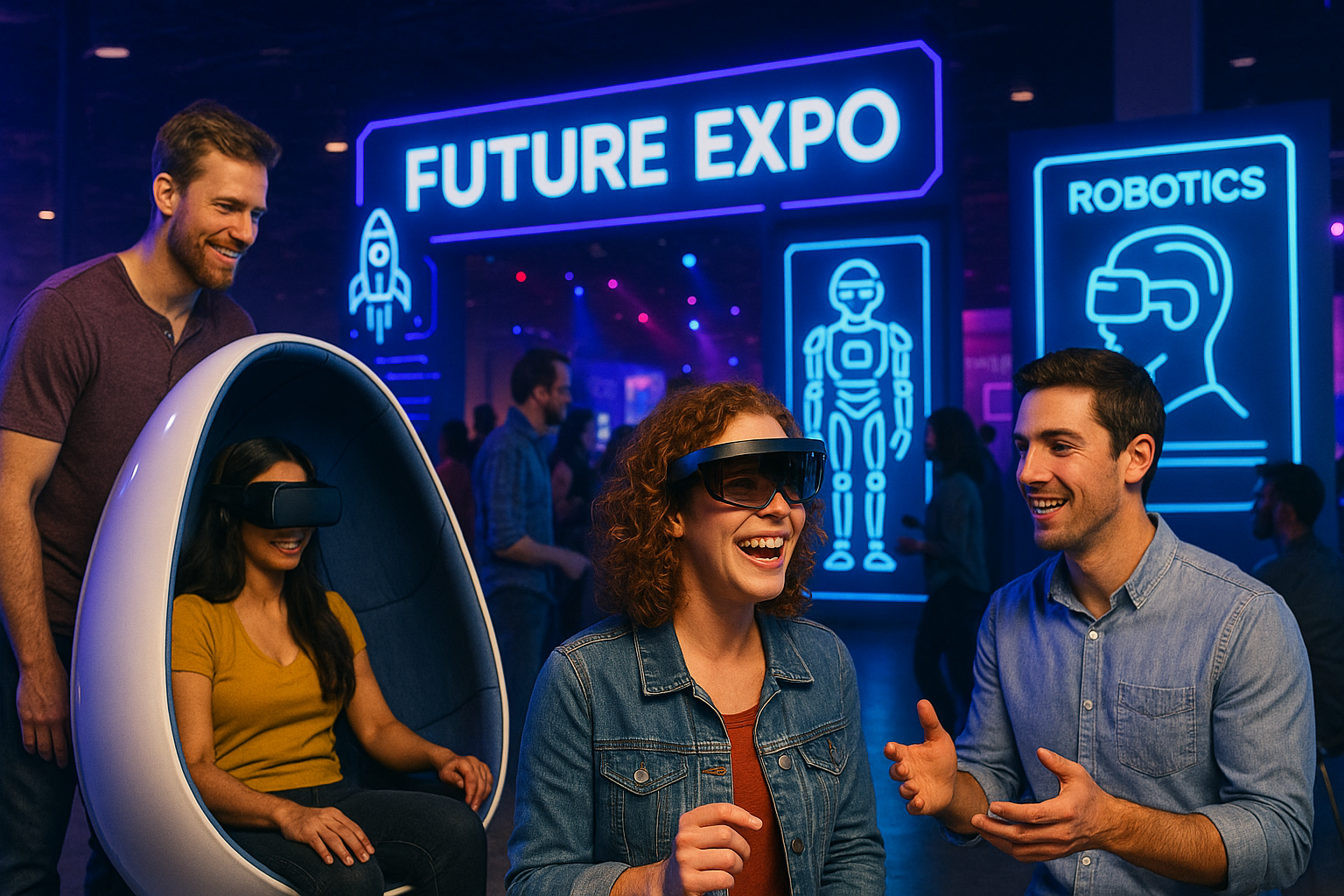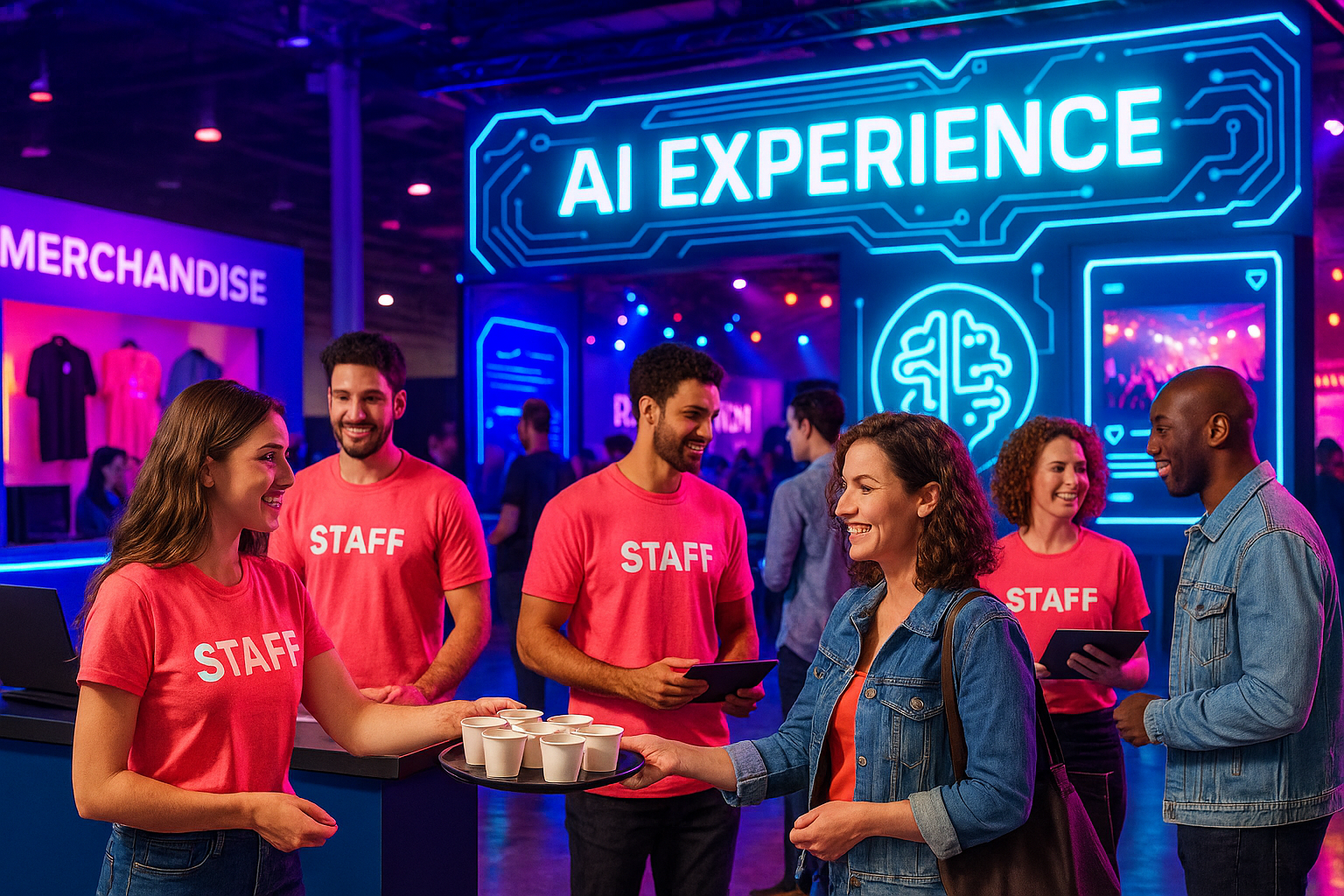Why In-Person Experiences Are Taking Over in an AI-Dominated World: A Deep Dive
Artificial intelligence is revolutionizing how brands create, distribute, and optimize digital content. From AI-driven copywriting tools to automated customer support, the internet is increasingly populated with synthetic interactions. According to Gartner, by 2026, 75% of enterprises will shift from piloting to operationalizing AI.
While this digital transformation drives efficiency and personalization at scale, it comes with an unexpected consequence: consumer fatigue and distrust of online content.
Multiple studies reveal that:
65% of consumers say they have difficulty trusting online information. (Edelman Trust Barometer, 2023)
78% report feeling overwhelmed by digital ads and content saturation. (HubSpot, 2024)
The solution? Brands are pivoting toward in-person experiences—immersive, face-to-face moments that cut through digital noise and foster deep emotional engagement.
This blog unpacks why in-person experiences are becoming the gold standard and how brands and marketers can capitalize on this seismic shift.
1. The Digital Saturation Problem: Why AI-Driven Content Alone Isn’t Enough
1.1 The Rise of AI Content Generation
AI tools like ChatGPT, Jasper, and Synthesia can generate vast amounts of written, audio, and video content in seconds. The market for AI content creation tools is expected to grow at a CAGR of 27% through 2028 (MarketsandMarkets, 2024).
Pros:
Faster content production
Personalization at scale
Cost savings on creative teams
Cons:
Content homogenization: AI tends to produce formulaic and generic outputs.
Lack of authentic human voice and creativity.
Over-saturation leading to declining audience attention.
As AI becomes more widely adopted, content strategies start to blur together. Brands are increasingly sounding the same, using identical phrasing, layout structures, and tone. This diminishes brand identity and weakens connection with audiences. Unique perspectives, once a brand's greatest differentiator, are becoming harder to recognize online.
1.2 Consumer Digital Fatigue
According to a 2024 Deloitte Digital Media report:
The average adult spends over 7 hours daily consuming digital media.
50% admit to “zoning out” or ignoring many online ads and messages.
Users experience this as mental fatigue. With limited energy for processing information, consumers start skipping, muting, or blocking content altogether. This puts digital-first campaigns at risk of invisibility, especially when they're not backed by emotional relevance or real-world credibility.
2. Why In-Person Experiences Deliver What Digital Can’t
2.1 Emotional Engagement and Memory Encoding
Neuroscience research demonstrates that physical experiences create stronger memory traces than passive digital consumption. A 2023 study by Harvard Business School found that immersive, multi-sensory experiences increase brand recall by 70%.
Live experiences engage more senses—touch, sight, sound, and even smell—which leads to deeper emotional imprinting.
This sensory engagement triggers the brain to create stronger associations between the brand and the emotional response felt at the event. Whether it's joy, curiosity, nostalgia, or surprise, those emotions become tied to the brand and significantly influence purchasing behavior.
2.2 Trust and Credibility
Face-to-face interaction builds trust through:
Non-verbal cues (eye contact, body language)
Immediate responses to questions and objections
Genuine enthusiasm and empathy
A Nielsen study revealed that 92% of consumers trust recommendations from real people over online ads. Real-world interactions provide authenticity that algorithms cannot replicate.
In-person events allow customers to see the product, talk to real people, and assess sincerity. They can ask tough questions and see how well your team knows the product or service. These moments are pivotal in winning over skeptical audiences.
2.3 Creating Social Proof and Viral Buzz
Experiential marketing sparks organic content creation. According to Event Marketer’s 2024 report:
83% of consumers post about their experiences on social media.
70% discover new brands through friends’ posts at events.
Photo booths, branded installations, giveaways, and influencer appearances all drive authentic word-of-mouth amplification.
Additionally, in-person experiences double as content creation hubs. Every selfie, live stream, or TikTok clip shared from your event becomes a micro advertisement—user-generated, free, and deeply trusted by others in their network.
3. Real-World Examples of In-Person Experience Success
3.1 Netflix House: Immersive Storytelling in Physical Space
Netflix is pioneering permanent immersive experience centers in Philadelphia and Dallas. These venues feature themed rooms, VR games, exclusive merchandise, and show-inspired food experiences. Shows like Stranger Things, Squid Game, and Wednesday come to life.
This strategy not only deepens fan loyalty but also generates incremental revenue streams beyond streaming subscriptions. It creates a theme-park feel without the roller coasters.
These experience centers also act as real-world testing grounds for new IP development. Netflix can observe how fans interact with different genres and characters, influencing decisions for future shows and merchandise.
3.2 Amazon Style and Retail Reinvention
Amazon Style stores offer digitally-enhanced in-person shopping. Shoppers scan items to have them delivered to fitting rooms, receive AI-driven suggestions, and complete purchases seamlessly.
Retailers like Apple, LEGO, and Nike have embraced the hybrid model, blending tech with real-world interaction. They create flagship experiences where customers can touch, test, and connect with the brand.
The key here is combining the efficiency of digital with the emotional engagement of physical retail. Amazon Style proves that automation and human interaction can coexist to provide a seamless experience.
3.3 Pop-Up Shops and Festival Activations
Pop-ups allow brands to create buzz with limited-time installations. Fashion, beauty, and tech brands use pop-up shops to launch products or test markets.
Festivals like Coachella and SXSW have become experiential playgrounds where brands build immersive tents, lounges, and giveaways to spark shareable moments.
These activations benefit from captive, engaged audiences. Attendees are in the mood to explore, interact, and share. It’s prime real estate for building brand equity.
4. The Growing Demand for Skilled Event Staffing
4.1 Why People Matter
Technology can enhance experiences, but it’s people who create emotional impact. Brand ambassadors, promotional models, product specialists, and event managers are the face of your brand in the field.
No amount of automation can replace a warm greeting, a confident product demo, or the ability to manage unexpected customer concerns. People bring intuition and improvisation—things machines can’t replicate.
4.2 What Brands Look for in Experiential Staff
Strong interpersonal communication
Product knowledge and the ability to educate customers
Professional appearance and behavior
Quick thinking and crowd management skills
The best staffers don’t just execute tasks—they represent the brand’s energy, values, and credibility.
More than ever, brands are prioritizing soft skills. Empathy, cultural fluency, and situational awareness have become vital for representing companies in diverse, high-touch settings.
4.3 Rise of Experiential Staffing Agencies
As demand increases, agencies specializing in event staffing have become essential partners. Agencies offer pre-vetted talent pools, training, and onsite support, reducing the burden on brand teams and ensuring event success.
Some agencies also provide coordinators, costume design, travel management, and even post-event reporting—making them end-to-end solutions for brands investing in experiences.
5. Integrating In-Person and Digital: The Hybrid Experience Model
Forward-thinking brands understand that the goal isn’t to choose between digital and in-person—it’s to blend them.
5.1 Pre-Event: Using Digital to Drive Attendance
Paid ads and email marketing to promote events
AI-driven personalization to recommend events or sessions
RSVP and registration tools to optimize planning
Personalized email sequences and targeted social ads can build hype leading up to an event. Influencer previews or behind-the-scenes sneak peeks also build anticipation.
5.2 During the Event: Tech That Enhances the Experience
QR codes linking to product demos, videos, or surveys
RFID wristbands for access control and engagement tracking
Social media integrations to share moments in real time
Digital tools should empower—not replace—human connection. A great example is photo stations that automatically email guests their branded photo and invite them to follow the brand’s social channels.
5.3 Post-Event: Data and Follow-Up
AI-curated content summaries
Email follow-ups based on attendee behavior
Remarketing to attendees with relevant offers
Smart brands treat post-event engagement like an extension of the event. Timely follow-ups, personalized discounts, and feedback surveys help solidify impressions and continue the conversation.
6. Economic Impact and ROI of Experiential Marketing
According to Freeman’s 2024 Global Brand Experience Study:
91% of consumers say they have more positive feelings about a brand after a live event.
85% are more likely to purchase after participating in an activation.
Experiential marketing drives results at every stage of the funnel:
Awareness: Foot traffic and viral exposure
Consideration: Hands-on product trial
Conversion: Promotional offers, exclusive deals
Retention: Emotional connection, loyalty rewards
Despite initial costs, in-person experiences can deliver better long-term ROI than purely digital campaigns. Their impact is measurable in both tangible metrics and intangible brand equity.
7. Future Trends: Where In-Person Is Headed Next
7.1 Micro-Experiences and Local Activations
Instead of massive events, brands are embracing localized experiences—smaller, more targeted, and highly curated. These allow for deeper connections and more personalized messaging.
This trend supports sustainability, community integration, and tailored messaging. It’s about showing up where people already are—their neighborhoods, campuses, or gyms.
7.2 Sensory and Immersive Design
Events are using scent marketing, immersive lighting, AR/VR integrations, and 360-degree storytelling to trigger emotion and memory.
These techniques turn passive observers into active participants. Sensory-rich environments help deepen brand recall and make the event "feel" like the brand.
7.3 Community-Centered Experiences
Brands are shifting from "spectator" events to interactive, collaborative experiences. Think brand-hosted workshops, neighborhood pop-ups, and open-mic-style engagement zones.
This creates a sense of ownership and belonging. When customers co-create the experience, their loyalty increases tenfold.
8. How to Start Building In-Person into Your Strategy
Step 1: Define Objectives
What is the purpose of the experience? Lead generation, awareness, trial, loyalty, or community?
Step 2: Know Your Audience
Use data to identify where your ideal customers are and what kinds of experiences appeal to them.
Step 3: Choose the Right Format
Options include:
Product sampling
Street team marketing
Pop-up events
Conference sponsorships
Brand-owned installations
Step 4: Hire the Right Team
Work with staffing agencies who understand experiential marketing and can provide trained, enthusiastic team members.
Step 5: Measure, Optimize, Repeat
Track:
Foot traffic
Dwell time
Social shares
Survey feedback
Conversion rates
Use this data to refine future activations.
Additionally, record qualitative feedback—not just metrics. Pay attention to how people talk about the brand during the event. What words do they use? What emotions come up? These are gold for shaping future campaigns.
Conclusion: Real Is the New Remarkable
In an era where AI dominates online interactions, real human moments stand out. In-person experiences are no longer a luxury or add-on—they are a strategic advantage.
They build trust. They drive emotion. They inspire action. And most importantly, they make people remember you.
As digital becomes more crowded and impersonal, brands that show up in real life have a powerful edge. If your goal is to create deeper connections, increase loyalty, and truly be remembered, experiential marketing must be a cornerstone of your strategy.
If your brand is looking for ways to break through the noise, it’s time to step out from behind the screen—and show up in the real world.


